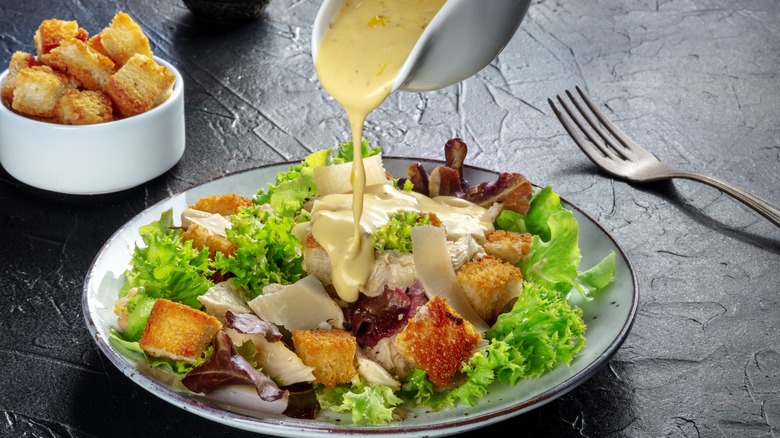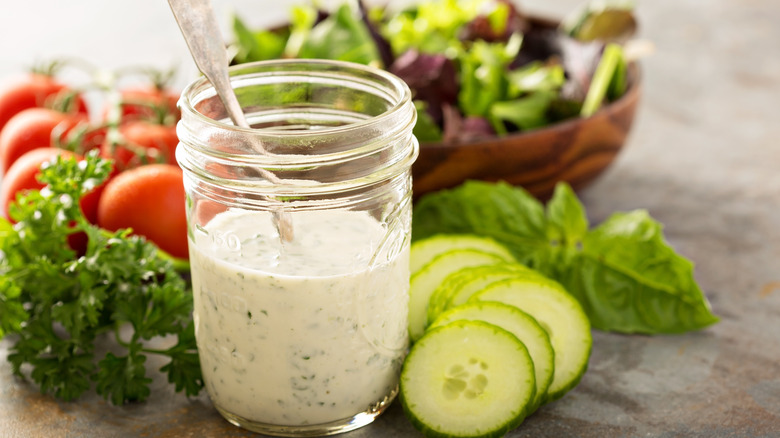The Shortcut Restaurants Often Take With 'Homemade' Dressings
Anyone who's ever set foot in a restaurant during a lunch or dinner rush knows that working in an eatery is not for the faint of heart. In addition to long hours, servers are subject to physically demanding work for the entirety of their shifts. This can entail carrying impossibly heavy trays packed with dishes and glasses to and from tables. Then consider the kitchen staff, who also clock long hours on their feet all day preparing meals for a steady influx of patrons. Kitchen staff must also labor away in increasingly hot temperatures thanks to stove tops and ovens, which can make work even more harrowing.
Accordingly, the staff at restaurants are usually under tight deadlines and faced with rigorous demands from the minute their shift starts. And servers have the added pressure of providing food and drinks with a smile and friendly demeanor, which is crucial when it comes to receiving the tips that many rely on just to make ends meet. Based on these factors, many staff members at restaurants look for harmless ways to make their jobs easier. This includes one common hack involving the authenticity of so-called "homemade" dressings.
Pulling back the curtain at your favorite restaurants
Even the best dining establishments may use hacks and shortcuts to better serve their customers. While it's not necessarily the case for every restaurant, it's quite common for establishments to use powdered eggs as opposed to the real deal. Made from dehydrated eggs, powdered eggs last longer and take up less room on shelves, which makes them perfect for bustling eateries. Additionally, you're unlikely to detect the difference between powdered versions and the real thing, as powdered eggs assume a similar taste and texture after water is added.
Equally surprising is the secret that numerous restaurants have when it comes to their dressings. Many establishments proudly feature their selection of homemade dressings on the menu, to the delight of diners who prefer real, wholesome ingredients. However, the common practice is to buy a big jar of the stuff and add ingredients to make it a little more enticing. Much like the use of powdered eggs, buying dressings in bulk and fancying them up is a lot more practical than having staff stop everything to whip up a new batch of balsamic vinaigrette or Italian every time they run out. Additionally, these methods can also mean a more flavorful product when compared to basic storebought dressing out of the bottle.
Not quite homemade, but better than the bottle
While not all restaurant dressings touted as homemade are the real thing, there's a good reason why dressing tastes better away from home than it does out of your fridge. Consider ranch dressing, a wildly popular dressing for salads, wraps, chips, vegetables, and just about everything else that's edible. Ranch is a fixture in numerous dining establishments, as well as having a cherished place in most refrigerators. When you purchase bottled ranch from the store, the primary ingredient is often vegetable oil, with dairy products serving as the co-stars. When you order ranch from a restaurant, you're most likely getting something a little extra.
Many restaurants use ranch packets, which usually consist of powdered buttermilk, as well as salt and herbs for a bit of flavor. These packets must be mixed with other ingredients, which is where the real magic happens. While it's not exactly homemade, adding ingredients like sour cream, black pepper, and chopped peppers to ranch packets is pretty similar to the method of making homemade ranch dressing. As a result, ranch from your favorite restaurant is bound to be a lot more flavorful, even if it isn't explicitly homemade.


